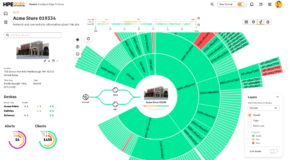
I’ve been talking with customers across the APAC region who are considering when and where Wi-Fi 6 (formerly known as 802.11ax) will be right for them. Those conversations have prompted me to consider how much wireless LAN design has changed since the early days of Wi-Fi.
Initial Design Priority: Convenience
I joined Aruba back in 2006, just before 802.11n was introduced.
In the beginning, people didn’t complain that 2 Mbps was too slow because being untethered was so great. Wi-Fi was a huge and novel convenience. But people quickly wanted more, and 802.11b gave way to 802.11a and 802.11g, which delivered then-blazing 54 Mbps data rates.
People were moving around in offices and warehouses, and they wanted to connect their laptops in conference rooms or use barcode scanners in warehouses. They wanted to use VoIP phones in buildings where their cell phones didn’t work. Mobility was just catching on, and back then, we designed Wi-Fi networks for RF coverage, not capacity.
Next, A Need for Higher Densities
The goal of 802.11n, introduced in 2007, was to increase the number of user devices per AP and to increase the net throughput per device. More people were using laptops and other Wi-Fi devices for work. Schools were giving students laptops in the classroom. Capacity suddenly mattered—a lot.
One of our biggest network design challenges at the time was classrooms. Typically, a single AP needed to support 30 devices and deliver consistently good behavior. Designing a WLAN to provide that experience was really hard. But in some ways, we didn’t know how good we had it. We were only dealing with one or at most two types of laptops and operating systems.
Then Apple introduced the iPhone and soon after the iPad, resulting in user demand for mobility exploding.
In 2013, 802.11ac supercharged 802.11n, promising potential gigabit speeds. 802.11ac delivered big improvements in per client throughput. Our customers typically achieved a 3X improvement in per client throughput and increased client densities per AP. But fundamentally neither 802.11n nor 802.11ac attempted to improve the fundamental inefficiencies in the 802.11 protocol.
In a crowded, diverse mobile world, speed alone was not enough.
A Focus on Optimization
Wi-Fi 6 puts the focus is on efficiency, not raw speed. Wi-Fi 6 does offer some increased per user throughputs with 1024 QAM but this is not its main objective. Wi-Fi-6 introduces technologies that address many of the inefficiencies all current Wi-Fi deployments endure. Its primary aim is to make more efficient use of the existing Wi-Fi bandwidth. The goal is to allow more users to share the same access point whilst at the same time increasing the net throughput per user.
Wi-Fi 6 improves the inherent inefficiencies in the 802.11 access method by implementing new technologies like OFDMA, Multi-User Uplink MIMO and BSS coloring. Wi-Fi 6 aims to deliver a better experience for everyone.
Wireless networks today must support not only many more devices, but also many different generations of device types and operating systems. Internet of Things (IoT) devices are ratcheting up the variety and complexity.
At the same time, organizations still use legacy Wi-Fi technologies, including 802.11ac Wave 1 and Wave 2, and even 802.11g, 802.11a and 802.11n. Many of these legacy devices will be around for years to come so Wi-Fi 6 needs to be backward compatible. We are eagerly awaiting the arrival of Wi-Fi 6 clients so we can begin to benefit from all of the technology advances.
Design Skills Have Advanced
Technology advances aside, there’s no substitute for experienced network engineers who can create a great design for customers beyond the default product settings. Despite how far Wi-Fi has evolved, it will not work well without a correct design. I’m still amazed at how many networks I encounter with default settings.
To deliver the user experience people expect, it’s critical to design the network based on the devices and use cases. Many network engineers use tools like Ekahau to do the site survey as well as to optimize and troubleshoot production deployments.
Understanding the functionality of the Aruba WLAN solution enables you to deliver the best possible experience for each deployment. The need for good WLAN design is ongoing. Environments are constantly changing. People move. Physical spaces are reorganized. And always, people expect amazing experiences.
There are many more ways to develop this engineering expertise, too. Organizations like CWNP provide vendor-neutral WLAN training and certification, whether someone is just getting started or a seasoned pro. Wireless LAN Professionals is a great community of people who work day in and day out with WLANs.
Tools to Optimize the Experience
No doubt you’ve been hearing a lot about the impact of artificial intelligence (AI) and machine learning (ML) on networking.
AI and ML can be applied to Wi-Fi to help better understand how the network is performing by using the large data set available for the examination from the millions of access points that our customers have deployed. By applying machine learning models, we can learn which configurations apply best to which deployment scenarios.
We have been doing this for a while now with tools like Aruba NetInsight. One interesting outcome has been the ML systems recommending configuration settings we would never have tried previously. This is because the ML systems are making use of a vast set of data that not even our best Wi-Fi engineers can simultaneously analyze. Not surprisingly, these settings have resulted in a better overall user experience.
We don’t know what the future holds, but we know that technology, skills and network designs will need to keep pace.




